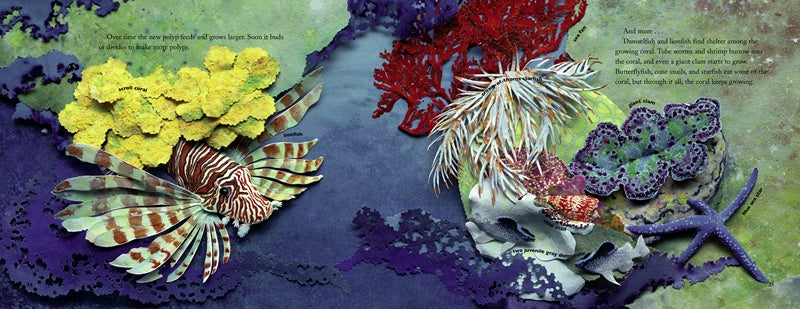One Night in the Coral Sea

Sneed B. Collard III, author
Sneed B. Collard III has been a biologist, computer scientist, and author. He began writing after graduating with honors in marine biology from the University of California, Berkeley. Sneed is the author of several children’s books, including, Creepy Creatures, Our Wet World, Forest in the Clouds, and One Night in the Coral Sea. He lives in Missoula, Montana.
Read more about Sneed.
Robin Brickman, illustrator
For nearly 30 years, Robin Brickman’s affinity for natural science and art has culminated into realistic illustrations like those found in One Night in the Coral Sea and Beaks! Her innovative illustrations entail a painstaking process of sketching, cutting, painting, gluing, and shaping. The finished 3-dimensional molds are then photographed and used as illustrations. Robin lives in Williamstown, Massachusetts.
Read more about Robin.
- NSTA/CBC Outstanding Science Trade Books for Students K-12
- John Burroughs List of Nature Books for Young Readers
- Charlotte Award Nominee for 2008 (New York State Reading Association)
School Library Journal
Brilliantly colored, 3-D paper sculptures were photographed to create the lush and surprisingly realistic illustrations that showcase the corals and other animals of the Great Barrier Reef. The focus here is on a unique event—the coral mass spawning that occurs one night a year. Coral reproduction is a relatively new discovery, and it is explained scientifically but simply.
Booklist
On a single spring night, after a full moon, the coral in the Great Barrier Reef releases millions of eggs into the ocean. Veteran science writer Collared explains the unique spawning event and provides some background about coral and the sea creatures that share the reef. His text is mostly clear and direct; still, younger children, particularly those who haven't encountered basic reproductive concepts, will need help grasping the science. But whether or not children understand the specifics of fertilization, they will be captivated by Brickman's realistic, astonishingly detailed colored-paper collages of teh brilliant underwater world. A closing image of a silvery moon illuminating dolphins splashing through a placid sea extends the shivery sense of mysterious, fascinating life teeming beneath the surface. Further information, a glossary, and resources are appended. Teachers may want to pair this with Lawrence Pringle's Coral Reefs, which features excellent color photographs that will partner nicely with Brickman's collages.
Deep Sea News
The most richly illustrated of all the books I reviewed. Brickman uses a diorama like paper cut-out technique with flower petals, dried seeds, and berries overlaid on dyed paper and papier mache. The story is rich and adventurous with a classic narrative style. "in late spring, a few days after the full moon, the sun sets over the Coral Sea." I loved it. The book tries hard to educate, spelling lar-vee phonetically, etc... but it does an excellent job detailing the intricacies of coral spawning, I dunno. Are fourth graders ready for this stuff?
Curriculum Connections
Using brilliantly colored, double-spread, sculpted-paper illustrations as a backdrop, the author describes the abundant sea life inhabiting Australia's Great Barrier Reef with a special emphasis on corals and their amazing annual mass spawning which sends "trillions of tiny sperm" in search of an egg.
NSTA Recommends
Although there are many books about coral reefs, this volume is truly unique. The graphics, with text undulating around intricate illustrations, makes this book entertainging as well as educational. Children will not want to put this book down.
The book focuses on a spring night after the full moon, when the mass spawning of coral takes place. More than 100 different species of coral simultaneously release million soft egg packets and sperm into the water. This phenomenon was discovered int eh mid-1080s and is still not fully understood. The author follows the development of a single coral from fertilization to the formation of a large colony, which is then ready for the next mass spawning.
The author includes background information about both hard and soft corals and samples from the tropical fish and other reef inhabitants. Several examples illustrate how coral is used for camouflage, as well as a feeding ground. More technical terms are written in bold print and are defined in the glossary at the back. There is also a reference section and a list of related websites.
This book could be used in teaching life cycles, animal adaptations, and symbiotic relationships. I highly recommend this book to teachers of grades 2 to 4 who wish to captivate their students while helping them to broaden their understanding of life on a coral reef. The mesmerizing illustrations will enable even younger children to grasp the concepts involved.
Kirkus Reviews
The creators of Beaks! nose out more wonders of nature with a visit to Australia's Great Barrier Reef. With Brickman's teeming marine scenes for visuals, done in intricately shaped and painted paper collage, Collard introduces a sampling of the vast array of tropical fish and other reef-dwelling fauna. Then in an awed tone, he describes the recently discovered and still unexplained mass spawning in which, on certain spring nights beneath a full moon, more than a hundred different species of corals simultaneously release vast clouds of sperm and trillions of egg packets. He goes on to trace the development of a single coral polyp from fertilization to a large colony ready for the the next spawning. Readers will come away intrigued by the phenomenon and eager to check out the multimedia resources on the appended list. This stands out from the school of other reef tours on library shelves, both for its special focus and for its riveting illustrations.
Paperback
ISBN: 978-1-57091-390-7
E-book PDF
ISBN: 978-1-60734-327-1
Ages: 6-9
Page count: 32
11 x 8 1/2





